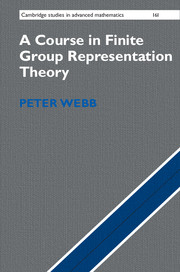Book contents
- Frontmatter
- Contents
- Preface
- 1 Representations, Maschke's Theorem, and Semisimplicity
- 2 The Structure of Algebras for Which Every Module Is Semisimple 15
- 3 Characters
- 4 The Construction of Modules and Characters
- 5 More on Induction and Restriction: Theorems of Mackey and Clifford
- 6 Representations of p-Groups in Characteristic p and the Radical
- 7 Projective Modules for Finite-Dimensional Algebras
- 8 Projective Modules for Group Algebras
- 9 Changing the Ground Ring: Splitting Fields and the Decomposition Map
- 10 Brauer Characters
- 11 Indecomposable Modules
- 12 Blocks
- Appendix A Discrete Valuation Rings
- Appendix B Character Tables
- Bibliography
- Index
6 - Representations of p-Groups in Characteristic p and the Radical
Published online by Cambridge University Press: 05 August 2016
- Frontmatter
- Contents
- Preface
- 1 Representations, Maschke's Theorem, and Semisimplicity
- 2 The Structure of Algebras for Which Every Module Is Semisimple 15
- 3 Characters
- 4 The Construction of Modules and Characters
- 5 More on Induction and Restriction: Theorems of Mackey and Clifford
- 6 Representations of p-Groups in Characteristic p and the Radical
- 7 Projective Modules for Finite-Dimensional Algebras
- 8 Projective Modules for Group Algebras
- 9 Changing the Ground Ring: Splitting Fields and the Decomposition Map
- 10 Brauer Characters
- 11 Indecomposable Modules
- 12 Blocks
- Appendix A Discrete Valuation Rings
- Appendix B Character Tables
- Bibliography
- Index
Summary
The study of representations of a group over a field whose characteristic divides the group order is more delicate than the case of ordinary representation theory. Modules no longer need be semisimple, and we have to do more than count multiplicities of simple direct summands to determine their isomorphism type. In this chapter, we begin the task of assembling techniques specifically aimed at dealing with this. As a first step, we focus on representations of p-groups in characteristic p. Specific things may be said about them with very little background preparation, and they have impact on representations of all groups. In subsequent chapters, we will gradually fill in the rest of the picture. We start by describing completely the representations of cyclic p-groups. We show that p-groups have only one simple module in characteristic p. We introduce the radical and socle series of modules and deduce that the regular representation is indecomposable, identifying its radical as the augmentation ideal. We conclude with a discussion of Jennings's Theorem on the radical series of the group algebra of a p-group in characteristic p.
Cyclic p-Groups
We describe all representations of cyclic p-groups over a field of characteristic p using elementary methods. In the first proposition, we reduce their study to that of modules for a principal ideal domain. When G is cyclic of order N, we have already made use of an isomorphism between kG and k[X]/(XN − 1) in Exercise 11 from Chapter 2. When N is a power of p, we can express this slightly differently.
Proposition 6.1.1. Let k be a field of characteristic p and let be cyclic of order pn. Then there is a ring isomorphism kG ≅ k, where k[X] is the polynomial ring in an indeterminate X.
Proof. We define a mapping
Since
this mapping is a group homomorphism to the unit group of, and hence it extends to a linear map
that is an algebra homomorphism. Since gs is sent to Xs plus terms of lower degree, the images of 1, …, gpn−1 form a basis of.
Information
- Type
- Chapter
- Information
- A Course in Finite Group Representation Theory , pp. 95 - 114Publisher: Cambridge University PressPrint publication year: 2016
